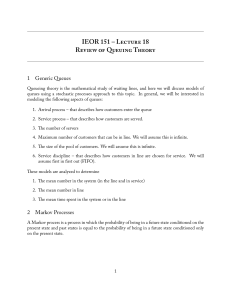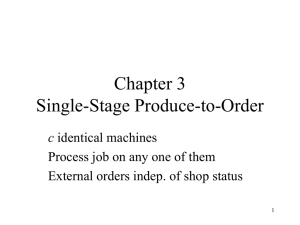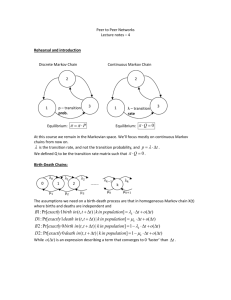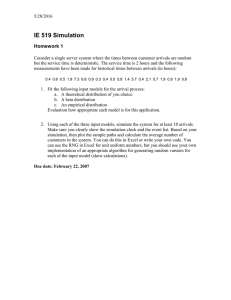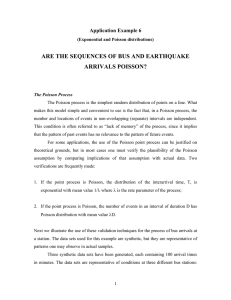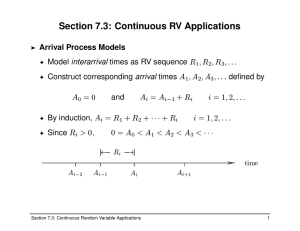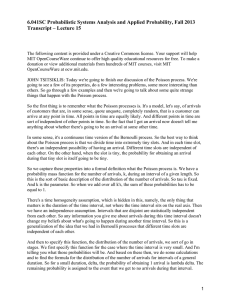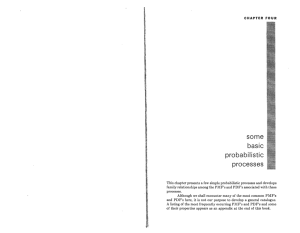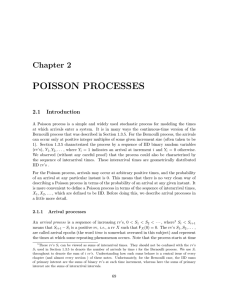Lesson 9. The Poisson Arrival Process 1 Last time...
advertisement
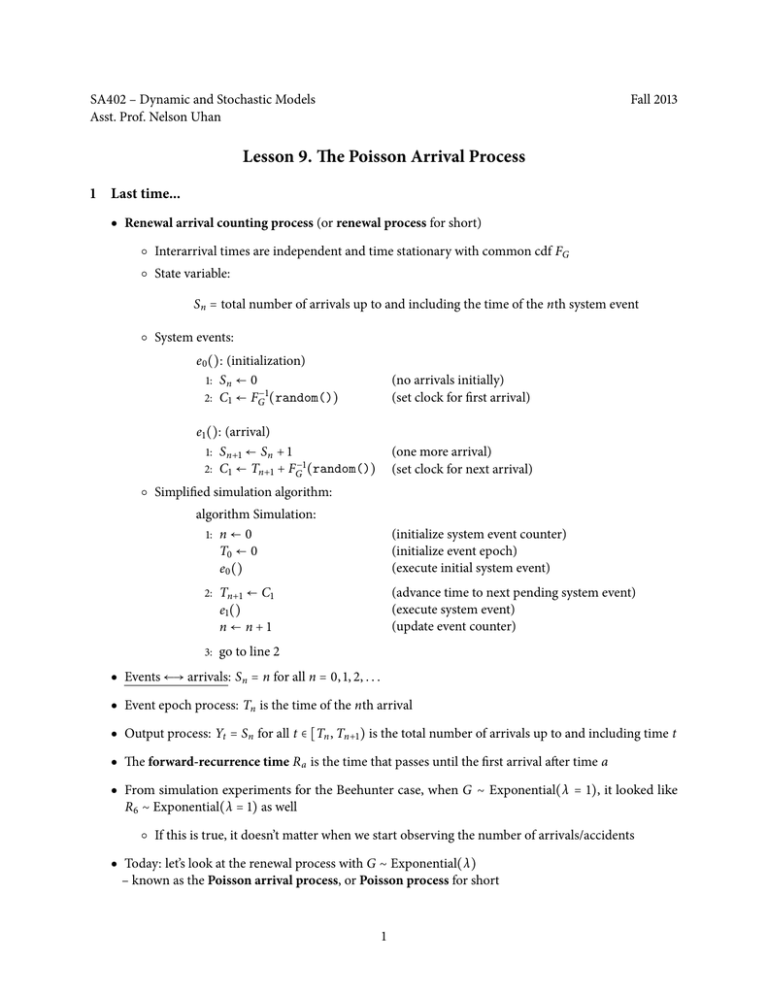
SA402 – Dynamic and Stochastic Models
Asst. Prof. Nelson Uhan
Fall 2013
Lesson 9. The Poisson Arrival Process
1
Last time...
● Renewal arrival counting process (or renewal process for short)
○ Interarrival times are independent and time stationary with common cdf FG
○ State variable:
S n = total number of arrivals up to and including the time of the nth system event
○ System events:
e0 (): (initialization)
1: S n ← 0
−1
2: C1 ← FG
(random())
(no arrivals initially)
(set clock for first arrival)
e1 (): (arrival)
1: S n+1 ← S n + 1
−1
2: C1 ← Tn+1 + FG
(random())
(one more arrival)
(set clock for next arrival)
○ Simplified simulation algorithm:
algorithm Simulation:
1: n ← 0
T0 ← 0
e0 ()
2:
Tn+1 ← C1
e1 ()
n ← n+1
3:
go to line 2
(initialize system event counter)
(initialize event epoch)
(execute initial system event)
(advance time to next pending system event)
(execute system event)
(update event counter)
● Events ←→ arrivals: S n = n for all n = 0, 1, 2, . . .
● Event epoch process: Tn is the time of the nth arrival
● Output process: Yt = S n for all t ∈ [Tn , Tn+1 ) is the total number of arrivals up to and including time t
● The forward-recurrence time R a is the time that passes until the first arrival after time a
● From simulation experiments for the Beehunter case, when G ∼ Exponential(λ = 1), it looked like
R6 ∼ Exponential(λ = 1) as well
○ If this is true, it doesn’t matter when we start observing the number of arrivals/accidents
● Today: let’s look at the renewal process with G ∼ Exponential(λ)
– known as the Poisson arrival process, or Poisson process for short
1
2 The Poisson arrival process
● Let G i be the interarrival time between arrivals i − 1 and i
● We can directly write the event epoch Tn as a function of the interarrival times G1 , . . . , G n :
● Since FG is the exponential distribution with parameter λ, FTn is the Erlang distribution with parameter λ
and n phases:
n−1 −λa
e (λa) j
FTn (a) = 1 − ∑
j!
j=0
● The output process Y1 , Y2 , . . . and the event epoch process T1 , T2 , . . . are fundamentally related:
Yt
...
t
● Therefore, we can get an explicit expression for the cdf of Yt :
● And we can also get an expression for the pmf of Yt :
● The pmf and cdf may look familiar: Yt is a Poisson random variable with parameter λt
⇒
E[Yt ] = λt
2
Var(Yt ) = λt
Example 1. In the Beehunter case, the inter-accident times were exponentially distributed with parameter λ = 1.
What is the probability that the total number of accidents at week 24 is greater than 30? (Your calculator can
evaluate summations with many terms: use the
button.)
3
Properties of the Poisson process
● Let ∆t > 0 be a time increment
● The independent-increments property: the number of arrivals in nonoverlapping time intervals are
independent random variables:
○ As a consequence:
● The stationary-increments property: the number of arrivals in a time increment of length ∆t only
depends on the length of the increment, not when it starts:
○ As a consequence:
⇒ λ can be interpreted as the arrival rate of the Poisson process
● The memoryless property: the forward-recurrence time R t has the same distribution as the interarrival
time:
● These properties make computing probability statements about sample paths of Poisson processes pretty
easy
3
Example 2. Recall that in the Beehunter case, a total of 103 accidents have occurred at the intersection up to
the time the traffic engineer starts observing, time a. What is the probability that more than 30 accidents are
observed in the following 24 weeks?
Example 3. What is the probability there are 4 accidents at week 5, given that there are 2 accidents at week 4?
● Any arrival-counting process in which arrivals occur one-at-a-time and has independent and stationary increments must be a Poisson process
○ If you can justify your system having independent and stationary increments, then you can assume
that interarrival times are exponentially distributed
○ This is a very deep powerful result
4
4
Why does the memoryless property hold?
● The memoryless property allows us to ignore when we start observing the Poisson process, since
forward-recurrence times and interarrival times are distributed in the same way
● “Memoryless” ←→ how much time has passed doesn’t matter
● Why is this true for Poisson processes?
Yt
...
t
Pr{R t > ∆t ∣ Yt = k} = Pr{R t > ∆t ∣ Tk ≤ t < Tk+1 }
= Pr{Tk+1 − t > ∆t ∣ Tk ≤ t < Tk+1 }
= Pr{Tk + G k+1 − t > ∆t ∣ Tk ≤ t < Tk + G k+1 }
= Pr{G k+1 > t − Tk + ∆t ∣ G k+1 > t − Tk , t − Tk > 0}
= Pr{G k+1 > t − Tk + ∆t ∣ G k+1 > t − Tk }
=
Pr{G k+1 > t − Tk + ∆t, G k+1 > t − Tk }
Pr{G k+1 > t − Tk }
=
Pr{G k+1 > t − Tk + ∆t}
Pr{G k+1 > t − Tk }
=
e −λ(t−Tk +∆t)
e −λ(t−Tk )
= e −λ∆t
Ô⇒
∞
Pr{R t > ∆t} = ∑ Pr{R t > ∆t ∣ Yt = k} Pr{Yt = k}
k=0
∞
= ∑ e −λ∆t Pr{Yt = k}
k=0
∞
= e −λ∆t ∑ Pr{Yt = k}
k=0
= e −λ∆t
● Therefore, Pr{R t ≤ ∆t} = 1 − e −λ∆t , and so R t ∼ Exp(λ)
● Along the way, we also showed that R t and Yt are independent
5
● Note: This proof is a little sketchy – we actually need to condition on Tk instead of treating it as a
constant
○ Works the same way, but with messier conditional statements and another use of the law of total
probability
● The independent-increments and stationary-increments properties follow from the memoryless property
and the fundamental relationship between Yt and Tn (see Nelson pp. 110-111)
6
